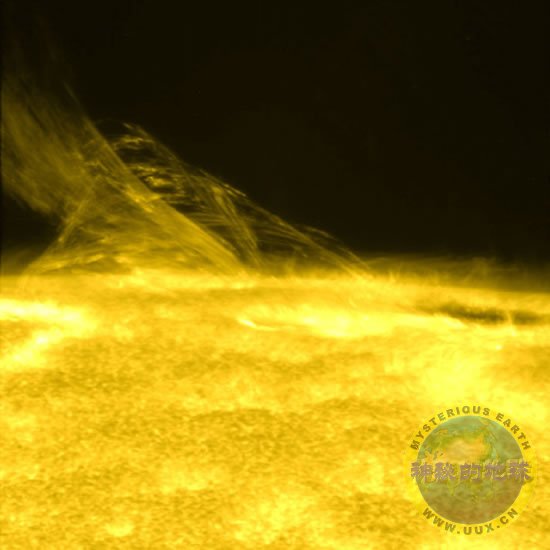Sun's Mysterious Waves Found; May Be Solar Wind Source
A large plume of gas known as a prominence shoots hundreds of thousands of miles out from the sun's surface at about six miles (ten kilometers) a second in this image from the Hinode spacecraft.
Images like these taken by the Japanese-led mission have definitively revealed mysterious magnetic waves that could be the source of solar wind, a suite of new studies reports.
Image © Science
Richard A. Lovett
for National Geographic News
December 6, 2007
Powerful magnetic waves in the sun's atmosphere may be the energy source that drives the solar wind, a suite of new studies from a Japanese-led mission reports.
These so-called Alfvén waves were first predicted by Swedish physicist Hannes Alfvén, who won the 1970 Nobel Prize in Physics for his theory. (Read about the winners of this year's physics Nobel.)
The new studies of these waves were made possible by high-resolution instruments on the Hinode satellite, which was launched in September 2006.
Hinode, which means "sunrise" in English, is a joint mission of the Japanese Aerospace Exploration Agency (JAXA), NASA, the Particle Physics and Astronomy Research Council (PPARC), and the European Space Agency (ESA).
The orbiter's instruments allowed researchers to take rapid-fire pictures of various solar structures (see a March 21, 2007, Hinode image of the sun's turbulent magnetic field.)
Certain images were then combined into movielike photo sequences that showed how several solar structures interact with the long-suspected magnetic waves.
"These observations are unprecedented," said Jonathan Cirtain, a solar astrophysicist at NASA's Marshall Space Flight Center in Huntsville, Alabama. "It's just like [the features] are waving at you."
Three different teams, including one led by Cirtain, announce the find in tomorrow's issue of the journal Science.
Like Plucking Guitar Strings
The solar wind sweeps charged particles through space at speeds of about two million miles (three million kilometers) an hour—meaning that charged particles from the sun reach Earth's orbit within a couple of days.
"We live in the atmosphere of the sun," said Bart de Pontieu, a solar physicist at Lockheed Martin Corporation's Solar and Astrophysics Laboratory in Palo Alto, California.
De Pontieu is lead author of another of the new Alfvén wave studies.
Normally the solar atmosphere is calm, but its wind can carry "space weather" from solar flares or other disturbances on the sun's surface.
These cause auroras, disrupt satellites and radio communications, and—in extreme cases—wreak havoc with power grids.
Understanding solar wind could help scientists better predict the impacts of space weather—but the exact source of the winds has long been a mystery.
In 1947 the physicist Alfvén published a paper in the journal Nature proposing the existence of electromagnetic-hydromagnetic waves.
Since then the waves have been produced in the lab, but it was not until recently that researchers could detect the waves in the sun's corona.
The new studies show that Alfvén waves occur when turbulence at or near the sun's surface causes magnetic field lines to produce wiggles that propagate outward.
"They're kind of like waves on a guitar string, in the sense that if you pluck a guitar string, the wave travels along [it]," de Pontieu said.
His team was able to spot the waves by looking at the motions of "spicules" in the chromosphere, a thin layer of the sun's atmosphere.
Spicules are jets of hot gas that shoot outward from the sun's surface at speeds of 100,000 miles (160,000 kilometers) an hour, reaching heights of 5,000 miles (8,000 kilometers) in a matter of minutes.
Using Hinode's high-speed camera, the scientists were able to photograph spicules every five seconds.
The jets are lined up along the sun's magnetic field lines, which stick out from the star's surface.
Alfvén waves make the spicules that form along the field lines seem to "dance," somewhat like a person wiggling a magnet in the middle of an array of iron filings.
X-Ray Jets
Similarly, the team led by NASA's Cirtain looked at the sun's x-ray emissions, particularly from high-energy jets near its magnetic poles.
These showed that Alfvén waves are created when tangled magnetic field lines "short circuit" and snap into new configurations. That causes the field lines to vibrate in response to the large quantities of energy being released.
Alfvén waves on the sun last for about ten minutes each, and Hinode's x-ray telescope allowed a new image to be taken every 30 seconds.
"We could directly observe the waves" moving in the images, Cirtain said.
Still another team, led by Takenori Okamoto of Japan's National Astronomical Observatory, was able to see similar effects in prominences, which are large plumes of gas rising hundreds of thousands of miles above the sun's surface.
Unlike spicules and x-ray jets, which lie near the surface, prominences extend into the sun's corona, where they can persist for many days.
As the Alfvén waves rise above the sun's surface, they impart energy to gases in the sun's corona, propelling them outward.
"[Alfvén waves] are very good at propagating through the [sun's] atmosphere because they don't get damped easily," Lockheed Martin's de Pontieu said. "They carry a lot of energy."
Not all of this energy reaches the corona, but mathematical simulations by de Pontieu's team indicate that enough does to accelerate the solar wind.
"There's kind of a wall between the chromosphere and the corona, and a lot of the waves get reflected," de Pontieu said.
"But we've been able to show that enough get into the corona to provide the energy to drive the solar wind."
Solar Forecasting
The new studies don't allow for prediction of solar flares and other disruptive explosions from the sun, the researchers caution.
"We're helping theorists develop better models of the formation of the solar wind," NASA's Cirtain said.
"The increased precision and accuracy of those models will allow solar weather forecasters to create a more accurate representation of the output of the sun on a day-to-day basis."












